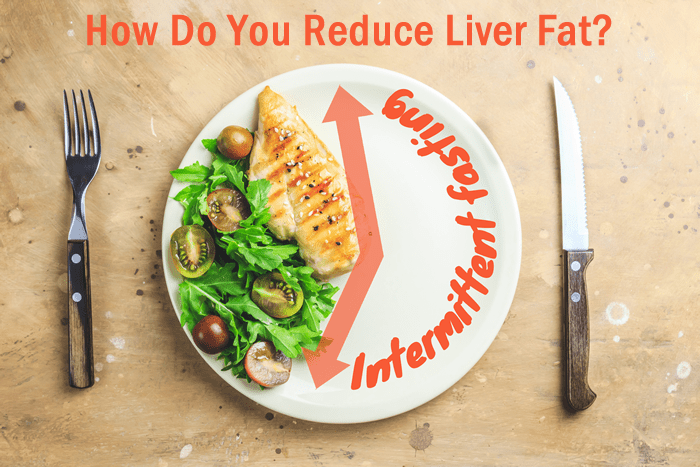
Previous
How Chlorella Benefits Liver Health & More

Next
You Can Check Your Liver's Health At Home
How Do You Reduce Liver Fat? New Study Suggests that Fasting and Exercise Can Help
Learn more about a study published in the journal Cell Metabolism that suggests fasting and exercise can help reduce liver fat.
While a higher level of liver fat may not cause issues for some people, in others, it can lead to damage to this essential organ. (1) What can you do to reduce your liver fat levels, potentially protecting it from harm? According to one study, combining intermittent fasting with aerobic exercise may help.
Fasting, Exercise, and Liver Fat
This study was published in the journal Cell Metabolism on January 3, 2023. (2) It involved 80 people with obesity and non-alcoholic fatty liver disease (NAFLD).
Subjects in the study were separated into four different groups.
For three months:
- one group engaged in intermittent fasting (IF) and moderate-intensity aerobic exercise
- one group engaged in IF only
- one engaged in exercise only
- and the final group did nothing, serving as a control.
The subjects’ intrahepatic triglyceride content was recorded before and after the study. Those engaging in both IF and aerobic exercise had “significantly reduced” liver triglyceride levels, particularly when compared to the exercise-only and control groups. Their alanine transaminase (ALT) levels decreased significantly as well. This is important because high ALT levels are associated with liver injury and disease. (3)
Other noticeable differences between the combination IF-exercise group and the control were that subjects in the combination group also had greater reductions in their body weight, fat mass, and waist size, while their insulin sensitivity increased.
What Is Intermittent Fasting?
Intermittent fasting involves going for extended periods of time without eating or having a greatly reduced calorie intake on certain days of the week. A common example of the latter is known as 5:2. This IF approach involves eating normally five days a week and, on the other two days, limiting caloric intake to just 500 calories.
In the case of the study above, participants in the intermittent fasting groups alternated fasting days with “feast days.” On the fasting days, they consumed 600 calories. On their feast days, they ramped up their intake to 2,500 calories.
IF approaches that involve going extended periods without food vary in terms of length. Some people follow a 16:8 schedule, for example, which means that they give themselves an eight-hour window to eat, then fast the remaining 16 hours of the day. Others shorten their eating window even more, following an 18:6 or 20:4 schedule instead.
Other Health Benefits of Intermittent Fasting
IF has been associated with many health benefits that extend well beyond the reduction of liver fat. Among them are: (4)
• reducing inflammation
• improving lipid metabolism
• lowering the risk of cardiovascular disease
• assisting with weight loss
• lowering blood pressure
• improving blood sugar control in individuals with diabetes
How to Engage in Intermittent Fasting
If you’ve never tried intermittent fasting, you may be wondering how to get started. As with any lifestyle change, taking small steps is a good way to get your body used to IF.
For example, if you want to try a 16:8 approach, start with a 12:12 schedule, where you eat during a 12-hour window, then fast for 12 hours. Once you’re comfortable with this, reduce your eating window by an hour and increase your fasting by an hour, so you’re following a 13:11 schedule. Keep making this progression until you’re at a 16:8 schedule.
Another option is to have a certain number of fast days per week. On the fast days, keep your calorie intake around 500-600 calories to get your body into a fasted state. If following this type of schedule, it doesn’t mean that you can eat without abandon on the days that you don’t fast. It’s still important to follow a healthy diet so you give your body the nutrients that it needs while avoiding substances that are harmful to it, such as saturated and trans fats, processed foods, and high amounts of sugar or salt.
Combining Intermittent Fasting with Exercise

It’s also important to remember that the study group that received the most benefit in terms of reduced liver fat combined IF with exercise. Specifically, they engaged in 60 minutes of moderate-intensity aerobic exercise five days per week. (2)
A moderate-intensity aerobic activity involves moving your body strenuously enough to increase your energy usage by three to six times when it is at rest. (5)
This includes:
- walking at a brisk pace
- bicycling with light effort
- and playing doubles tennis.
While the study involved participants getting 300 minutes of moderate-intensity exercise weekly, the Physical Activity Guidelines for Americans indicate that there are still “substantial health benefits” associated with at least 150 minutes of exercise per week. (6) So, if you’re currently sedentary, this may be a good goal to work toward at first. You can then progress to 300 minutes per week, easing into a more active lifestyle.
(1) Cleveland Clinic. (2020, July 31). Fatty liver disease. Retrieved April 04, 2023, from https://my.clevelandclinic.org/health/diseases/15831-fatty-liver-disease
(2) Ezpeleta, M., Gabel, K., Cienfuegos, S., et al. (2023, January 03). Effect of Alternate Day Fasting Combined with Aerobic Exercise on Non-Alcoholic Fatty Liver Disease: A Randomized Controlled Trial. Cell Metabolism. doi:10.1016/j.cmet.2022.12.001
(3) MedlinePlus. (2022, August 03). ALT Blood Test. Retrieved April 04, 2023, from https://medlineplus.gov/lab-tests/alt-blood-test/
(4) Malinowski, B., Zalewska, K., Węsierska, A., et al. (2019, March 20). Intermittent Fasting in Cardiovascular Disorders—An Overview. Nutrients. doi:10.3390/nu11030673
(5) Harvard T.H. Chan School of Public Health. (n.d.). Examples of Moderate and Vigorous Physical Activity. Retrieved April 04, 2023, from https://www.hsph.harvard.edu/obesity-prevention-source/moderate-and-vigorous-physical-activity/
(6) U.S. Department of Health and Human Services. (2018). Physical Activity Guidelines for Americans, 2nd Edition. Retrieved April 04, 2023, from https://health.gov/sites/default/files/2019-09/Physical_Activity_Guidelines_2nd_edition.pdf






